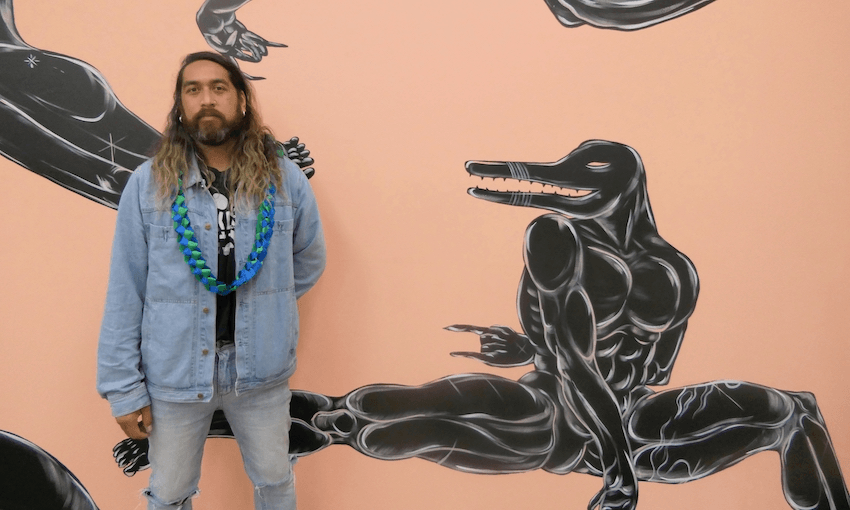After three decades in existence, Tautai Contemporary Pacific Arts Trust has launched its own gallery on Auckland’s Karangahape Road.
The first thing that hits you entering Tautai Gallery’s inaugural exhibition, Moana Legacy, is the range of works on show. On one huge wall is a mural of black humanoid crocodiles on a pink background by neo-pop artist Ahsin Ahsin (Atiu, Aitutaki), while the wall opposite has an illustrated hiapo (Niuean tapa cloth) made using traditional methods by Cora-Allan Wickliffe (Ngāpuhi, Tainui, Alofi and Liku) and her sister Kelly Lafaiki.
Elsewhere, a specially constructed frame holds ghostly photographs by Talia Smith (Cook Islands, Samoan and New Zealand European) and these sit across hangings of tiny, intricate kete made by Gina Ropiha (Ngāti Kahungunu/Ngāti Kere, Ngāti Raukawa/Ngāti Rakau) from her own hair, while around a corner a dark corridor is filled by an installation of neon blue tubes created by Israel Randell (Tainui, Ngāti Kahungunu).
Tautai founding patron Fatu Feu’u sees this gallery space as the eventual end point of work that he began over 30 years ago. In the 80s, he recalls Colin McCahon saying to him that the New Zealand art world was waiting for Pacific artists to make a serious contribution. The history of progress during the intervening years is evident all around you at Tautai.
Wickliffe’s work is an example of this. She speaks of the influence of legendary NZ Niuean artist John Pule and how their families both came from the same village in Niue. His work proved that the imagery of hiapo had a place in fine art and her work takes the logic one step further – his work was on canvas, while her hiapo are created using traditional materials and patterns. By bringing hiapo out of the museums and into a gallery space, Wickliffe pushes forward the argument for their place in the contemporary artistic conversation.
Wickliffe took this notion further in her introductory speech for the opening exhibition (which she curated). Pointing to one work, she told the audience it was an unfinished work dedicated to her grandfather who passed away last year. She then proceeded to “complete” the work by painting thick strokes of black paint over the face of the piece, erasing the illustrations and thereby evocatively expressing her loss, while the audience watched on in shocked silence.
Many of the artists on display in the opening exhibition also took part in Tautai’s groundbreaking show in Naarm/Melbourne last year, so the return to Auckland had a sense of homecoming. For Ahsin Ahsin, the trip was his first involvement with Tautai and he found it refreshing to connect with other artists from a Pacific background without any pressure to perform their culture in their art.
“I got to hang out with brown artists, which is quite rare for me. I’m based in Hamilton and there’s not many brown artists in the art community… It’s just about self-expression. I’m from the Pacific so that makes it Pacific art, but I do what I do.’
In the future, Ahsin hopes to collaborate with another artist who showed at both exhibitions, Rangituhia Hollis (Ngāti Porou, Ngāti Kahungunu), since they both also create digital work. Hollis’s advanced digital imagery had its own juxtapositions within the current exhibition: firstly with three charcoal/painted works he created to sit alongside them, but also in contrast with the videos created by Brisbane-born Fijian artist Mereani Qalovakawasa, which purposefully use the simplistic software of MS Paint to add a primacy to her work about life with a chronic illness (lupus).
Hollis was among four artists with Māori heritage in the show (making up half the participants), which reflects Tautai’s recognition of moana nui a kiwa – that all Pacific peoples derive from the same ocean. Hollis says he got a huge amount from being involved in the Tautai exhibition in Naarm/Melbourne, since it also involved trips to local galleries hosted by indigenous curators and opportunities to examine the Pasifika collection at the museums. He is equally impressed by the open, expansive layout of the new gallery:
“I think the utilisation of the space is amazing. I’ve seen it in other forms when it was Artspace and the Film Archive. Artspace had a lot of storage space but this seems to be space for people, not storage for archived items.”
Naawie Tutugoro (Kanak and Anglo-Argentinian/European) is one emerging artist involved in Moana Legacy who understands how far Tautai has come to get to this stage. Her father, Luke Tutugoro, was involved with Tautai from its inception and when she was a child he enlisted her to paint the garage of their Grey Lynn villa with nuclear-free messages as part of a Tautai-led campaign. She therefore appreciates the gravity of having her work on display on the opening night.
“It feels like tonight we are planting a tree that is going to be very sacred for the generations to come. I feel very lucky to be opening this space and have work that instigates that.”
The Moana Legacy exhibition is open until September 18.
